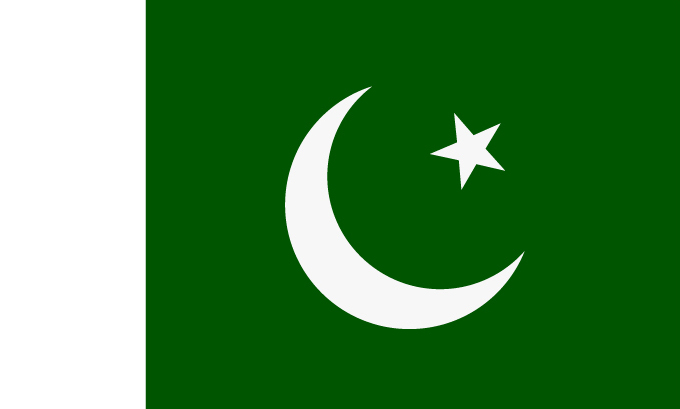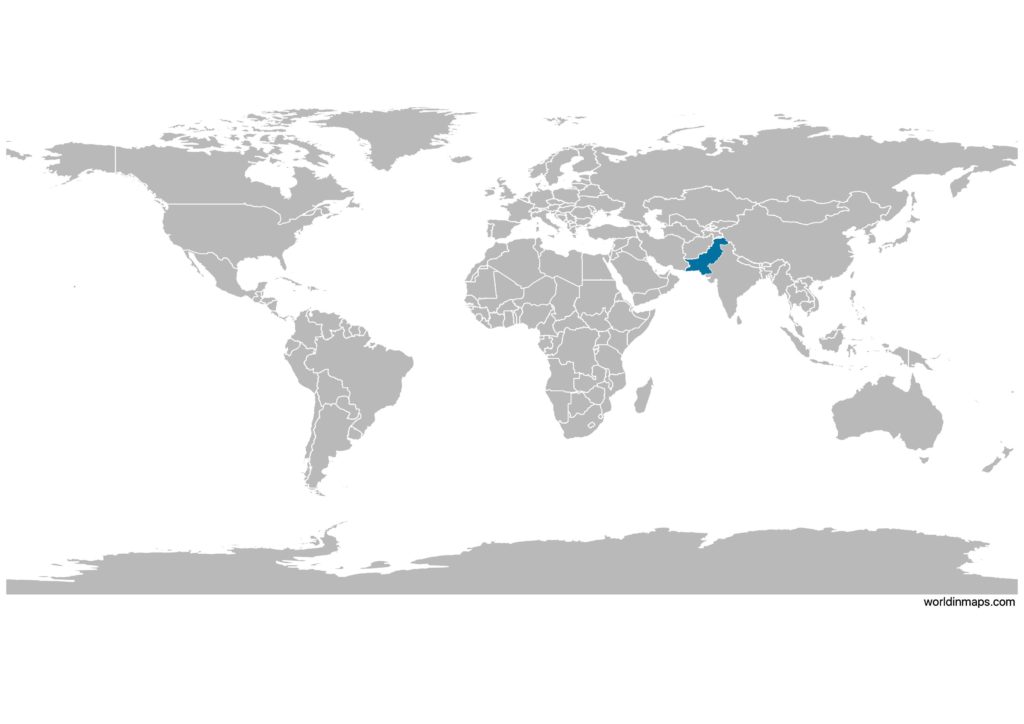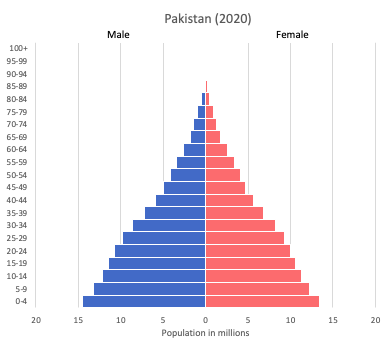Pakistan

| Government | |
| Name | Islamic Republic of Pakistan |
| Urdu | اِسلامی جمہوریہ پاكِستان Islāmī Jumhūriyah Pākistān |
| Government type | federal parliamentary republic |
| Capital | Islamabad(1,009,832 (2017)) |
| Currency | Pakistani rupee (PKR) |
| Organization | |
| Member State | South Asian Association for Regional Cooperation (SAARC) Commonwealth of Nations |
| People | |
| Population (2020) | 220,892,331 (5th) |
| Density of population | 244.4 P/km2 (56th) |
| Nationality | Pakistani |
| Official languages | |
| English | |
| Urdu | |
| Recognised regional languages | |
| Punjabi | 39% |
| Pashto | 18% |
| Sindhi | 15% |
| Balochi | 3% |
| Ethnic groups | |
| Punjabi | 44.7% |
| Pashtun (Pathan) | 15.4% |
| Sindhi | 14.1% |
| Saraiki | 8.4% |
| Muhajirs | 7.6% |
| Balochi | 3.6% |
| Other | 6.3% |
| Religions (2010) | |
| Muslim (official) | 96.4% |
| Sunni | 85-90% |
| Shia | 10-15% |
| other | 3.6% |
| Life expectancy (2020) | |
| Male | 67.2 years |
| Female | 71.3 years |
| Total population | 69.2 years (171st) |
| Homicides | |
| Total (2018) | 3.9 per 100,000 people (75th) |
| Geography | |
| Land area | 770,875 km2 |
| water area | 25,220 km2 |
| total area | 796,095 km2 (37th) |
| Mean elevation | 900 m |
| Lowest point | |
| Arabian Sea | 0 m |
| Highest point | |
| K2 (Mt. Godwin-Austen) | 8,611 m |
| Land use (2011) | |
| Agricultural land | 35.2% |
| Arable land | 27.6% |
| Permanent crops | 1.1% |
| Permanent pasture | 6.5% |
| Forest | 2.1% |
| Other | 62.7% |
| Urbanization | |
| Urban population (2020) | 37.2% |
| Rate of urbanization | 2.53% annual rate of change (2015 – 2020) |
| Economy | |
| Labor force (2017) | 63.89 million (9th) |
| note: extensive export of labor, mostly to the Middle East, and use of child labor | |
| Labor force by occupation (2015) | |
| Agriculture | 42.3% |
| Industry | 22.6% |
| Services | 35.1% |
| Unemployment rate (2017) | 6% (90th) |
| note: Pakistan has substantial underemployment | |
| GDP (PPP) (estimate 2020) | |
| Total | $1.254 trillion (23rd) |
| Per capita | $6,016 (132nd) |
| GDP (nominal) (estimate 2019) | |
| Total | $284.2 billion (42nd) |
| Per capita | $1,388 (151st) |
| GDP by sector (estimate 2016) | |
| Agriculture | 24.4% |
| Industry | 19.1% |
| Services | 56.5% |
| Exports (2017) | $32.88 billion (60th) |
| Exports partners (2017) | |
| US | 17.7% |
| UK | 7.7% |
| China | 6% |
| Germany | 5.8% |
| Afghanistan | 5.2% |
| UAE | 4.5% |
| Spain | 4.1% |
| Imports (2017) | $53.11 billion (51st) |
| Imports partners (2017) | |
| China | 27.4% |
| UAE | 13.7% |
| US | 4.9% |
| Indonesia | 4.3% |
| Saudi Arabia | 4.2% |
Pakistan on the world map

Pakistan top 10 largest cities (2017)
- Karachi (14,916,456)
- Lahore (11,126,285)
- Faisalabad (3,204,726)
- Rawalpindi (2,098,231)
- Gujranwala (2,027,001)
- Peshawar (1,970,042)
- Multan (1,871,843)
- Hyderabad (1,734,309)
- Islamabad (1,009,832)
- Quetta (1,001,205)
Demography
Population pyramid

Age structure data
Estimate for 2020:
- 0-14 years: 36.01% (male 42,923,925/female 41,149,694)
- 15-24 years: 19.3% (male 23,119,205/female 21,952,976)
- 25-54 years: 34.7% (male 41,589,381/female 39,442,046)
- 55-64 years: 5.55% (male 6,526,656/female 6,423,993)
- 65 years and over: 4.44% (male 4,802,165/female 5,570,595)
Remark: the age structure of a population affects a nation’s key socioeconomic issues. Countries with young populations (high percentage under age 15) need to invest more in schools, while countries with older populations (high percentage ages 65 and over) need to invest more in the health sector. The age structure can also be used to help predict potential political issues. For example, the rapid growth of a young adult population unable to find employment can lead to unrest.
Population from 1950 to 2020
Source: United Nations, Department of Economic and Social Affairs, Population Division (2019). World Population Prospects 2019, Online Edition. Rev. 1.
Evolution of the life expectancy from 1960 to 2018
Source: World Development Indicators, The World Bank
Economy
Agriculture:
cotton, wheat, rice, sugarcane, fruits, vegetables, milk, beef, mutton, eggs
Industries:
textiles and apparel, food processing, pharmaceuticals, surgical instruments, construction materials, paper products, fertilizer, shrimp
Exports – commodities:
textiles (garments, bed linen, cotton cloth, yarn), rice, leather goods, sporting goods, chemicals, manufactures, surgical instruments, carpets and rugs
Imports – commodities:
petroleum, petroleum products, machinery, plastics, transportation equipment, edible oils, paper and paperboard, iron and steel, tea
Time zone and current time in Pakistan
Go to our interactive map to get the current time in Pakistan